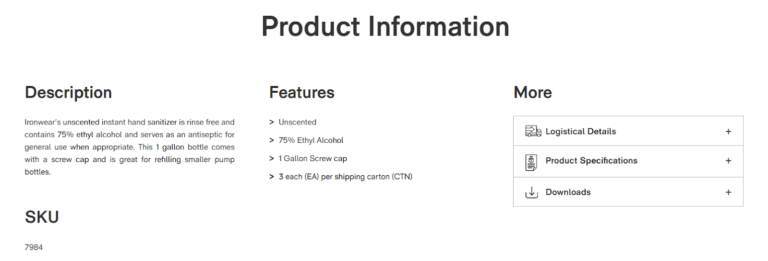In conjunction with professional product photography, your product videos can make or break your eCommerce brand.
Why? Because they are a key part of your product marketing strategy, on- and off-site — or at least they should be!
So what makes a product video a winner, and how do you ensure that they are doing their job: informing, entertaining, and, of course, selling?
In this post, we answer just that. We cover everything you need to know to make a product video that converts, including:
We have also included winning eCommerce product video examples throughout.
Let’s get started.
Best Types of Product Videos for eCommerce
Before we get into the why and how of successful product videos, let’s start by breaking down all the types of product videos available to you.
Yes, eCommerce product videos can be a powerful conversion tool, not just on-site but in marketing campaigns, social campaigns, and email. In fact, according to Hubspot, video is now the top type of content used by marketers to sell products.
However, it is all about using the best type of eCommerce product video to match your objective and channel.
It’s also important to note that not all product video types will speak to your market, so test a host of video types to find ones that perform well for your market, niche, and goals.
Here are seven main product videos any online store should be testing:
- Product Demo Videos
- How To / Product Explainer Videos
- Product Comparison / Selection Active Product Videos
- Promotional Product Videos
- Review / Customer Testimonial Product Videos
- Interactive Product Videos
- Livestream Product Videos
1. Product Demo Videos
A product demo video is as straightforward as it sounds. This is a product video that demonstrates a single product highlighting size, style, features, and/or material through full views and close-ups. These videos are generally used on product pages and range between 15–30 seconds in length.
The whole point of a good product demo video is to let your audience see exactly what they are buying, allowing a potential customer to experience the product without being able to touch it or see it in person. That’s not to say they need to be boring.
Product Video Example
Vat19 have combined a wide variety of video types to find a super creative way to demo their products with video, with styles changing to suit each specific product. They also incorporate eCommerce YouTube videos, meaning they use videos off- and on-site. Here’s one example:
Their product videos are displayed not just on product pages but on their home page and category pages.
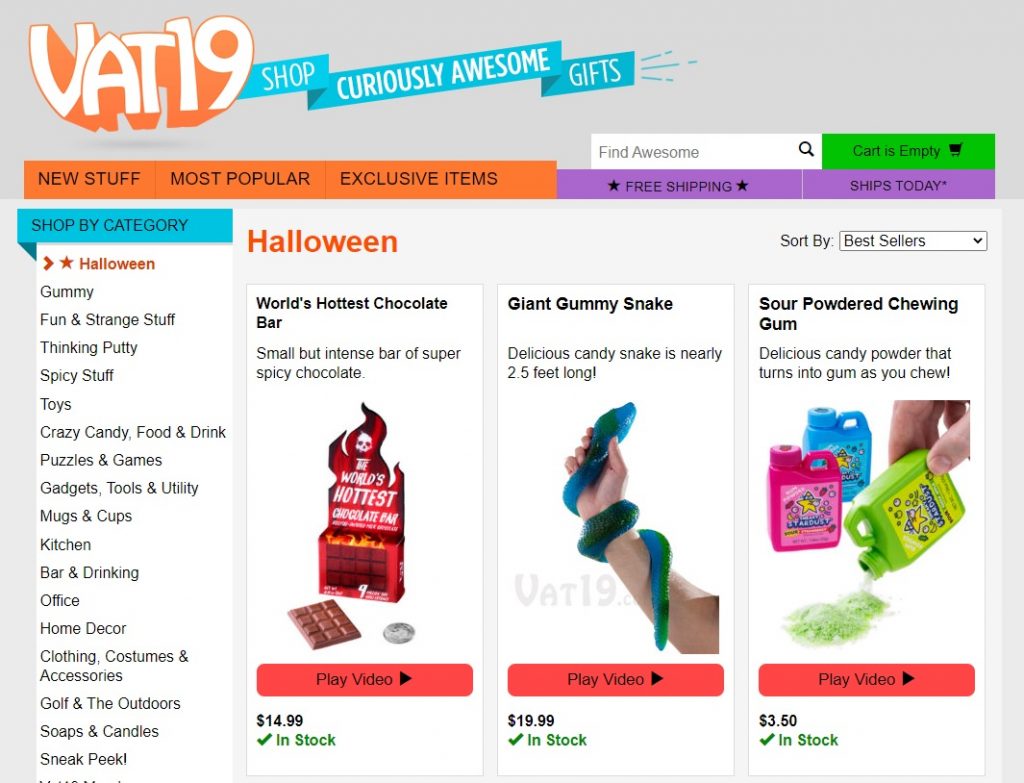
And the potential? According to one study, product pages with videos saw a 340% increase in viewing time and an 85% increase in conversions.
2. How To / Product Explainer Videos
More detailed, explainer videos (also known as how-to videos) take demo videos further. Getting more involved, these videos showcase the complete range of a product’s features, explaining how a customer can use a product in great detail.
These types of videos are not just appreciated by potential shoppers but by new customers who often (68%) prefer to watch an explainer video on how to use or fix a product rather than contact customer support.
As explainer videos are far more involved, they can be as long as seven or eight minutes, depending on how complicated your product is.
Pro Tip: Have you considered using FAQ videos to upgrade your eCommerce FAQ page? It may be a good idea to include explainer videos or how-to demonstrations along with answers to questions, especially if product installation or usage is complicated. Tools and video makers like Wistia can help with just that.
3. Product Comparison / Selection Active Product Videos
Another type of product video worth testing for product marketing, in the right context, is the comparison video. Also referred to as selection active videos, these product videos are designed to help customers choose between two varieties of the same product or two similar products from two different brands.
[embedded content]
[embedded content]
Product Comparison Video [ Animation ] from Mera on Vimeo.
4. Promotional Product Videos
Promotional product videos are video advertisements that you see on TV, social media, websites, and more. They are usually used for paid ads on digital platforms and generally meet a higher product video production quality standard.
That’s not to say that you have to spend tens of thousands of dollars on promotional product videos. Remember the below promotional video ad from Dollar Shave Club? Online viewers put the product cost of this promotional video ad at only $4,500, and generated millions of views and international news coverage. (Mind the f-bombs!)
[embedded content]
The key to creating winning promotional product videos is keeping them short and entertaining while using creative stories to highlight a product’s USP (unique selling proposition).
5. Review / Customer Testimonial Product Videos
Another type of product video worth considering for your online store home page or off-site product marketing is review or customer testimonial videos. The most significant benefit of this type of video is that it allows a potential customer to see reviews and testimonials from loyal shoppers who have bought and loved your products.
Additionally, when authentic, these videos build trust. They can also have a fantastic reach when combined with influencer marketing on Instagram or TikTok. In fact, some of the best-performing eCommerce TikTok video ideas come from TikTok viewers.
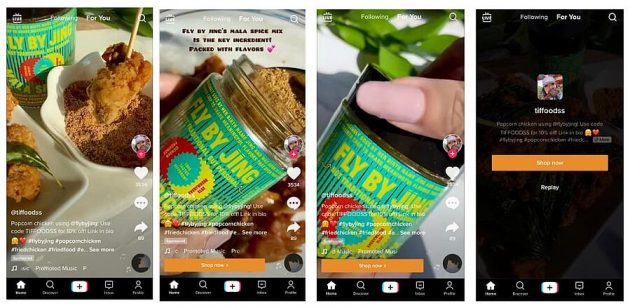
[Source: HubSpot]
Pro Tip: Want to automatically add customer testimonials to product pages? There are a host of tools and apps you can use to streamline your review video collection. Loox, for instance, is a popular Shopify review app that also includes video collection in their pro plans.
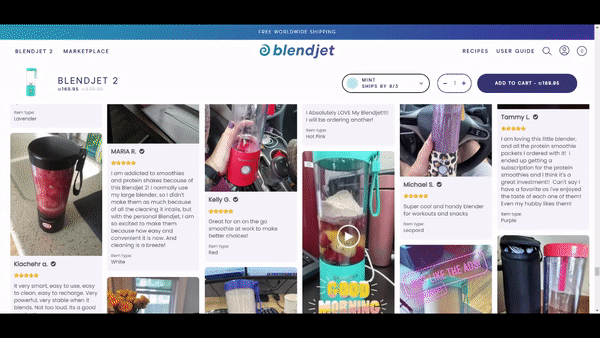
[Source: Loox]
Let’s not forget a special unboxing video mention! A subset of review videos, unboxing videos have become huge on social media, especially YouTube. And when tied with well-matched micro-influencers, brands can successfully widen their reach. But of course, packaging and after-sale service needs to be on-point for this to be effective.
Here’s an example from a YouTube influencer that combined a Happy Socks unboxing video with a CTA giveaway:
[embedded content]
6. Interactive Product Videos
The newest product video type on the list are interactive videos. These can be as simple as shopping cards and clickable CTAs on YouTube ads, or more involved like this IKEA interactive product video created by WIREWAX, who are now part of popular video marker Vimeo.
[embedded content]
Ultimately, they are designed to enhance the customer journey and encourage engagement.
According to Rock Content, 88% of marketers say interactive content helps brands differentiate themselves. And when you look at the general rise in AR trends in eCommerce based on consumer demand, it shouldn’t be surprising.
The trick to their success is ensuring a level of gamification and entertainment that makes viewers feel part of the story.
7. Livestream Product Videos
Live Commerce is growing daily, and with it, Livestream product videos. Livestream product videos allow eCommerce brands to interact directly with customers and potential shoppers to build trust while answering important buying questions in real-time.
Product Video Example
A popular online retailer having a lot of success with Livestream videos is Birchbox.
Their secret? Combining several popular product video elements into their live streams.
In the product video example below, a Benefit Cosmetics rep (Expert) put their new BADgal mascara (going into that month’s subscription box) on the Birchbox host.
What to Include in a Product Video and Why?
Whether you’re creating simple white background videos to highlight your product features on product pages or planning your holiday promotion ads, product videos should speak to your audience in their language while ensuring they line up with your eCommerce brand.
A winning product video is likely to:
- Tell a story. Even if through striking visuals or close-ups of a product, a good product video tells a story.
- Draw a user in immediately. With any video content, the first 5 seconds count the most. This is especially true if the product video is going to be used for social media and PPC marketing. Why? Brands need to compete with a lot of content, and competitive brands and first impressions matter.
- Include a compelling CTA. A good product video should include at least one CTA directing a potential customer to an action after viewing. (Here are 17+ Call-to-Action Examples to get you started.)
- Speak a shopper’s language without compromising the brand. Don’t jump on video trends unless they suit your market, brand, or target audience. To create a product video that converts, online stores should balance their brand voice with the tone of their language.
- Highlight key product features. Product videos are ultimately there to enhance the online shopping experience by providing an inside look at a product without the shopper having to see it in person. This is especially important for product videos intended for online merchandising or for complex or high-end products that need additional information.
- Answer critical questions or provide a solution. For your on-site product videos or product marketing reels, ensure you answer potential shoppers’ key problems or highlight the right product features to show how it is a solution to a problem they have.
Having said all that, however, it’s important to note that there is no one-size-fits-all approach to creating winning product videos. While some product videos excel when they are short and sweet, other, more involved or higher-end products, will need longer videos to adequately convey product features.
So, what makes a good product video? One that is tailored specifically for your audience in a way that highlights the product while not diminishing brand credibility.
Therefore, above all else, the most important factor of a winning product video is that it has been created, tweaked, and tested for your specific audience, product, and niche.
How to Make a Product Feature Video?
Whether you are shooting product videos in-house with the help of video markers, or opting for video production agencies, you still need to lay the proper foundation for a successful video. Here are some must-follow steps to get you on track:
Let’s quickly go through these steps in more detail.
Step #1: Define Your Product Video Goal and Choose Your Channel
The first thing eCommerce marketers should do when creating a product video is to clearly define the goal and channel. Why? For a product video to convert, it has to be suited to the channel and purpose.
You will want to ask yourself some of these questions:
- Do you need the video to raise brand awareness, such as with a TikTok video campaign, enhance your product page, or drive retargeted traffic to a new product launch?
- What results are you expecting from your videos — clicks, views, reach, or sales?
- Which channel will you be posting your video to?
That’s not to say you can’t utilize one video for multiple channels, like Vat19 has done (mentioned above). It all depends on your specific brand and product. Let’s take a look at the product page video for Allbirds, one of Shopify’s top brands:
Product Video Example
Let’s take a look at an example of Allbirds’ product videos. Designed specifically for their product pages, they are simple, clean, and focus on what matters: their shoes.
In fact, if you’re looking for a little more inspiration, Allbirds are experts in product page layout. As you can see below, they use a variety of elements to showcase every possible angle of their products, including white background product photos, lifestyle photos, and of course, product videos.
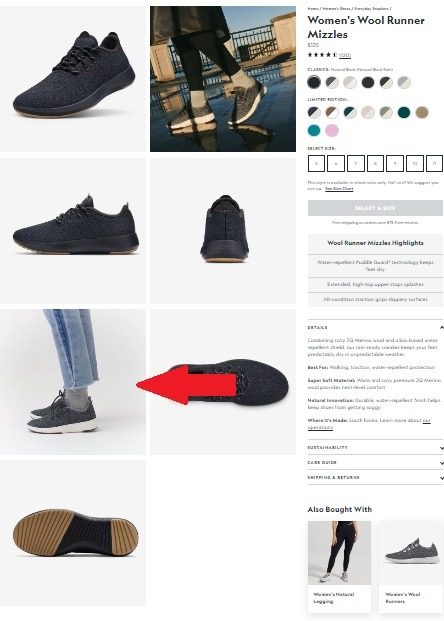
Step #2: Narrow Down Your Target Audience
Are you creating a video for all site visitors, or are you trying to target previous customers? Is the video going to reach potential customers who don’t know your brand at all? Are you talking to a specific group of people with similar problems that need solving?
You will want to define your target audience before deciding on your product video idea.
Why?
Not all product videos will appeal to your entire market — especially promotional product videos. Instead, you want to narrow down specifically which segment of your audience you wish to target.
Step #3: Set Budget
Another vital factor to consider when making product video decisions is your budget. Whether you’re working with an agency or not, you still need to determine what you want to spend on your product videos.
And how much do product videos cost, on average?
You’re looking at around $1,200–$50,000 for a premium video with production companies, or less than $5,000 (for buying equipment) if you do it in-house. Or, if you are really on a tight budget, you can use a video maker such as Canva Animoto. Here’s a breakdown of some of the more popular options:
List of Video Makers for Product Videos
- Adobe Spark
- Canva
- Amimo
- WeVideo
- Wideo
- Adobe Premiere Pro (for editing self-shot videos)
You can find and compare the complete list in our 33+ Best Video Editing Software for eCommerce post.
For product page videos, you will probably want to factor in the price of adding video with your overall product photography budget. However, for other types of videos, such as explainers, customer testimonials, or interactive videos, you will need to drill down a price.
Step #4: Choose Between Animation or Live Action
Your budget, along with your objective and audience, will determine whether you want to go animation or live action when making your product video. Animation is often a little cheaper than live action. However, it only suits specific products. Winning tech product videos, for example, often incorporate animation.
[embedded content]
Newbie Tip: Motion graphic videos are growing in popularity, and chances are you’ve heard of them in terms of video marketing products. If not, what are motion graphics? Sometimes referred to as “mograph,” a motion graphic video includes digital footage or animation snippets that create the illusion of motion or rotation.
Here are motion graphic trends from Envato:
[embedded content]
Step #5: Plan Your Structure and Build Your Script
Even if you’re using an agency or a freelance videographer, you will want to give them a rough idea of structure at this point. How long will the video be? What formatting do you need to consider for the channel? What is your rough outline for content, and do you have brand criteria they need to follow?
If you and your product marketing team plan on producing your product videos in-house, then you will need to go into more detail. You will also need to build your script. The script is what sets the pace and feel of your video marketing, as well as the desired CTA.
Pro Tip: How to Write a Product Video Script
To write a good video script, Hubspot recommends the following:
- Start with a good outline, and then write your intro or hook
- Use the middle of the video to highlight a problem your product solves, and end your video with resolution and a call to action
- Write conversationally and be thorough — script every single line and action
- Do a few run-throughs off camera and tweak accordingly
Step #6: Film or Create Your Product Video or Video Brief
Lastly, you will want to shoot or create your product video. Or, if using a freelance videographer or production company, submit your product video brief.
If you’re new to videography, shooting in-house, or have a limited budget, you will want to read the next section that will give you top tips to do just that.
Best Practices to Make a Product Video That Sells
No matter which type of product video you’re looking to create, brands should aim to:
Let’s take a look at each product video hack in more detail.
1. Opt for High-Quality Footage
Out-of-focus or blurry videos could immediately turn customers off.
Product videos are often the first impression your potential shoppers get of the products you sell and their unique features. Therefore, prioritizing high-quality product video production, especially when using them for product page displays, is definitely preferred.
Even if you are on a tighter budget and shooting plenty of product videos in-house, there are still ways you can ensure your videos are professional looking. Here are some tips from Wave.video to get you started. When shooting your product videos:
- Prevent shaky footage by using a tripod or placing the camera on a solid surface
- Aim for crisp, clear audio
- Shoot from a variety of angles
- Opt for a clear background
- Use plenty of consistent light
Choose the right video editing software
2. Focus on Your Audience
Your product videos should speak directly to your audience. Not only by using their language but also by answering their questions or addressing their pain points.
Why?
You can have the most professional product video there is in your niche. But if the solution doesn’t match up to your audience’s problem, or if the tone is not in line with their demographics, it won’t convert.
To ensure this doesn’t happen, ensure that you have your buyer personas front of mind when planning your video content and product promotion videos. Your video should answer key questions such as:
- In what way does the product bring happiness or relief?
- Why should a customer buy this product?
- What are the top features of this product, and what problems does it solve?
- How does the product make a customer’s life better?
A good example of this is from the folks at Kelty.
Product Video Examples
Kelty is an outdoor gear brand that offers shoppers “an easy and spontaneous excuse [they] need to get out there and escape from the mundane.” Their product videos match both the tone of their brand and speak directly to their target audience.
[embedded content]
3. Add, Test, and Tweak Call-to-Actions
A CTA is vital to the success of any video content, whether it’s a statement within the audio, a button (Facebook and Instagram), a title card at the end of a video (YouTube), or text overlays.
Always ask yourself what action your new potential shoppers and customers should take after watching an explainer video or expert interview. This is where CTAs come in. Choosing your call-to-action will depend on the video’s objective and the channel you are marketing to.
4. Optimize Your Product Video Length to Best Suit the Channel
As a rough rule of thumb, you want to aim for:
- 15–60 seconds for quick product demos
- 30–90 seconds for promotion product videos and customer testimonials
- 30–120 seconds for in-depth product demos
But that’s not always the best approach.
Yes, in general, shorter is better. But it’s not set in stone. Rather, you should be optimizing your video length to the channel you’re using and the message you want to convey. You should also consider the type of video you are making.
For instance, a product video that’s part of your product page would be short and straightforward, while a YouTube promotional video designed to tell a story can be much longer. Take GoPro’s “Be a Hero” campaign video, for example. It comes across as more of a documentary than a video ad, which suits the channel, their objective, their brand, and, of course, their market.
[embedded content]
5. Invest in a Quality Script (Promotional Product Videos) for Video Creation
Your script matters, especially when DIYing your promotional product videos or working closely with a freelance videographer. A good script should tell a story, be cohesive, and form a blueprint for the video. This will ensure your product video has a clear point of view for success while also preventing costly shooting mistakes or unnecessary retakes.
Even if you’re shooting dialogue-free product videos for product pages, you want to ensure you’ve thoroughly planned the format, tone, and product angles you want to show in the time you have.
Here are some script tips to get you started:
Script Writing Tips for eCommerce
- Invest time in the overall structure of your product video
- Plan all the imagery and audio, even if just background music
- Build a flow (from main body to final CTA)
- Run A/B tests before investing in expensive equipment or production agencies
Don’t forget to fully consider and optimize the product video pace and tone. The feel of your video is just as important as the features of your product, and you will need to consider this when planning your structure, scripts, and shot formats.
For instance, the more information you plan on giving the viewer in a shot, the longer it should be on screen. Or, your static shots should be shown for a shorter duration than that of your moving shots.
Product Video Example
A product launch video can be incredibly powerful, and when planned and scripted to perfection, even more so! We showed you the Dollar Shave Club video marketing example above; let’s look at another product launch video example from a top product that has had a lot of success.
[embedded content]
As you can see, in their new product launch video, Wild addresses all possible questions that a potential customer may have through an awesome script, flow, and format.
6. Optimize Your Product Video to Best Suit Each Product Marketing Channel
While you can definitely repurpose video content to use on a variety of channels, you still need to edit it to suit each channel.
For example, on TikTok, your videos are likely to be more informal and include voice-overs and hashtags designed to engage viewers. The product video on your homepage to launch a product, on the other hand, would require more quality imagery and product video production.
Additionally, each social media and marketing channel will have its own requirements that product marketing teams need to follow. Here are some of the top channels:
- Your website and product pages. The formatting and style of these product demos will depend on your own style and brand. They are displayed in your page’s product gallery or in the product description.
- Facebook and Instagram video. We all know just how powerful Facebook videos can be. Your product video requirements will depend on the eCommerce Facebook campaign or post you use for product marketing. They do give sellers a chance to show multiple videos in one ad, helping to improve ROAs.
- YouTube video. YouTube is considered the leading video social media platform, which makes it a top choice for a promotional product video. Your videos will need to be adapted to the specs of the types of videos or ads you’re using. You can read more about that here.
- Amazon video. In Amazon Seller Central, eCommerce sellers can add an Amazon video on their product displays. In these videos, Amazon sellers can’t include web links, URLs, or calls to action that direct the customer away from the product detail page.
- TikTok video. TikTok is becoming a popular choice for product marketing. Unlike other videos, TikTok offers a more relaxed space built around user engagement. Not sure TikTok video is suitable for your brand? Check out these three guides: Winning TikTok Video Ideas and Best Practices [+ Examples], [Case Study] 9+ Winning TikTok Ad Examples and Why They Work and The Ultimate Guide: TikTok Ads for eCommerce
7. Take Advantage of Video Elements Such as Captions, Subtitles, or Descriptions
On busy social media channels with a lot of noise, you must do what you can to stand out. This means taking advantage of crucial video elements these channels offer, such as captions, subtitles, and descriptions.
Why? You need to be able to get your message across without sound. On most social media channels, users are watching without sound. The Drum report claims that on LinkedIn, for example, 79% of videos are watched on mute.
Tip: New to eCommerce videography? Check out this guide from professional creator Sebpic on creating good quality product videos.
[embedded content]
Now let’s look specifically at product videos for product pages.
Benefits of Adding Product Videos to Product Pages
There are numerous benefits to including product videos in your product displays on your website and on marketplaces, such as an Amazon product video you add in Seller Central. Here’s a breakdown:
- Reduce return rates. Giving potential customers a better impression of your product’s product pages to show how one product works well with others in real-life scenarios improves the chance they are satisfied when they receive their order, decreasing overall return rates.
- Drive average order values (AOVs). eCommerce brands can use product videos to highlight how products work well together. Which, in turn, can help with upselling before checkout. This, in turn, helps improve AOVs.
- Ability to connect directly with customers. Product videos are a great way to connect with potential customers from brand awareness campaigns. They do this by showing traffic exactly how your brand and/or product solved a specific problem they have. Additionally, showing product benefits in real-life scenarios helps build trust.
- Increase conversions. Offering product displays in the form of live-action product videos gives potential customers a better idea of the product they are interested in. According to one study, as many as 64% of shoppers say they are more likely to buy a product after seeing a video.
- Enhance product value. Unlike product photography, product video enables advertisers to show all the key features of a product. This makes it easier to establish value, which in turn helps a potential customer make a buying decision.
- Optimize and increase SEO. We know that eCommerce SEO optimization is a vital component of product marketing for long-term growth. One study found that websites see 41% more web traffic from searches than non-users. There are a lot of factors marketers assume to play a part in this stat, including video making popular snippets for Google search and video keeping potential customers engaged with content for longer.
- Enhance branding authenticity. Another benefit of adding product videos to a product page or landing page is branding enhancement. Why? Video marketing offers a great way to build trust and authority, ultimately improving brand perception, even for first-time visitors.
- Better explain tricky products or concepts. As we mentioned earlier, product photography is limited in how much it can show. Product video, on the other hand, can extend engagement enough for brands to better explain product features. This is particularly helpful for more complex products.
- Improve eCommerce ROIs. Adding video product displays doesn’t have to be expensive, and the benefits are great. They also help engage your viewers (shoppers) for longer, improving your overall rankings and chances of conversions, thus improving ROIs.
Final Thoughts: Combine Product Images with Product Video to Enhance the Customer Journey and Boost Sales
As you can see, there are many reasons to incorporate product videos into your marketing and product displays. And whether you opt to create videos in-house or outsource to an agency, there is a solution to fit almost any budget.
And why should all eCommerce brands and online store marketers be testing product videos?
Because the overall benefit is a better shopping experience. And as we know, an improved and optimized customer journey means more trust, better brand impression, more sales, and ultimately, long-term success.
Still have questions? Post them in the comment section below!

Nicole Blanckenberg
Nicole is a content writer at StoreYa with over sixteen years experience and flair for storytelling. She runs on a healthy dose of caffeine and enthusiasm. When she’s not researching the next content trend or creating informative small business content, she’s an avid beachgoer, coffee shop junkie and hangs out on LinkedIn.
Comments
comments
Powered by Facebook Comments



